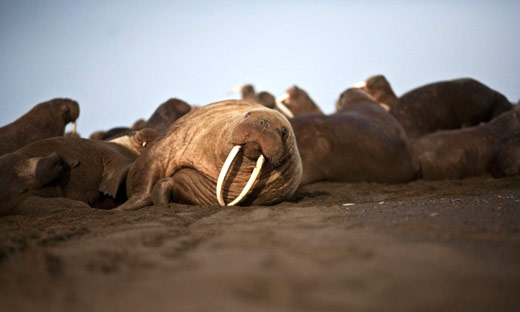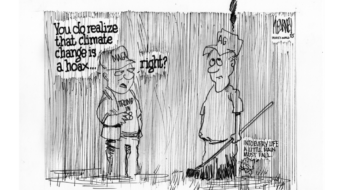
The temporary exile of some 35,000 walrus on a shore near Point Lay, Alaska can be blamed entirely on climate change. Without a nearby source of sea ice on which to spend the winter, the mammals, which unlike seals cannot swim for extensive periods of time, have been forced to come ashore seeking refuge. There they remain, in record numbers, confused and stranded. It’s just the latest price that wildlife is paying for the warming of the Arctic.
This has happened before. In fact, annually since 2007, walrus have been gathering en masse on Alaskan beaches in gradually increasing numbers. This new phenomenon is due to the dwindling sea ice, which has historically been important for female walrus to give birth, and for the animals to use as diving platforms to catch prey in more shallow areas of the ocean. However, ice has receded so far north that the water there is too shallow for walrus to dive to the bottom. This has left them stuck in the southerly region, where sea ice is now scarce. Scientists and conservationists are concerned over their new behavior, unsure as to whether it will negatively impact their wellbeing, and even fearing it could possibly render them endangered.
Scientists first spotted the herd on Sept. 25 while conducting an aerial survey of the area. Since then, the U.S. Fish and Wildlife Service has requested that air traffic avoid coming near the mass of animals, who are already frightened and could be provoked into a stampede, which could crush and kill small calves.
Traditionally, walrus have moved in tandem with the ice during the season, following it into the Bering Sea as it receded northward, and ultimately ending up in the Chukchi Sea for the summer. That ice no longer exists. And that is disrupting their migratory patterns, according to Tony Fischbach, a wildlife biologist with the U.S. Geological Survey who’s a member of an Alaskan Walrus Research Program. “Under historical conditions,” said Fischbach, “there has always been sea ice over the Chukchi Sea over the summer. This is a real change that we see thousands and tens of thousands of animals coming to shore and resting together in these large haul-outs.”
Experts consider these mass gatherings to be yet another wake-up call to the dangers of global warming. The congregation could also be seen as its very own form of protest against climate change – certainly, it’s a mammals’ Occupy movement, and it doesn’t seem as though the walrus will be moving for a while. Margaret Williams, managing director of the World Wildlife Fund’s Arctic program, said, “The massive concentration of walrus onshore – when they should be scattered broadly in ice-covered waters – is just one example of the impacts of climate change on the distribution of marine species in the Arctic.”
Fischbach added, “This behavior raises a lot of questions about whether the walrus will run out of food in the surrounding area,” due to the high number of walrus competing for sustenance there. “Occupying these areas concentrates tens of thousands of walrus in a smaller area that is already known to be less rich than their offshore foraging ground, and there is a concern that they could deplete the resources. It really appears that this is a new phenomenon for them. How they respond in the long term is an open question.”
One could hope that the walrus get out of this tight spot by next year, when Royal Dutch Shell rears its ugly head and begins its Arctic drilling project – a plan that could put all of the Arctic in danger. The corporation submitted its new drilling plan to the U.S. Department of Interior on Aug. 28, and while a final decision has not yet been made, both scientists and environmentalists would consider it a disaster if Shell began tampering in the sensitive ecosystem. The consequences of an oil spill there would be unthinkable.
Back in 2011, when the walrus issue was first making headlines, Shell was quickly developing its Arctic drilling strategy. Rebecca Noblin, Alaska director of the Center for Biological Diversity, remarked, “It’s a painful irony that on the same day” the Department of Interior said that no further research was needed on the impacts oil drilling would have on Arctic wildlife, “distressed walrus were seen hauling themselves onto shore because there’s no ice where they need it. The Arctic is reeling from climate change.”
Margaret Williams, the World Wildlife Fund’s Arctic programs director, explained that Shell will encroach on vital walrus habitat if it moves forward with its plans, and that both ship traffic and oil spills present great risks to the animals. “It’s an amazing place that’s full of life, with a very rich food chain,” she said. “If drilling goes forward, you have a huge potential mess.”
The biggest threat presented by the gathering alone, however, is that of stampeding. Lori Polasek, a marine biologist at a research and wildlife rehab facility called the Alaska SeaLife Center, said that if there’s a disturbance, “the calves get trampled. If the ice continues to wane, they’ll continue to come on land and you potentially have more stampedes. Then it’ll be a pickle where the population can’t recover.”
Photo: Ryan Kingsbery/U.S. Geological Survey










